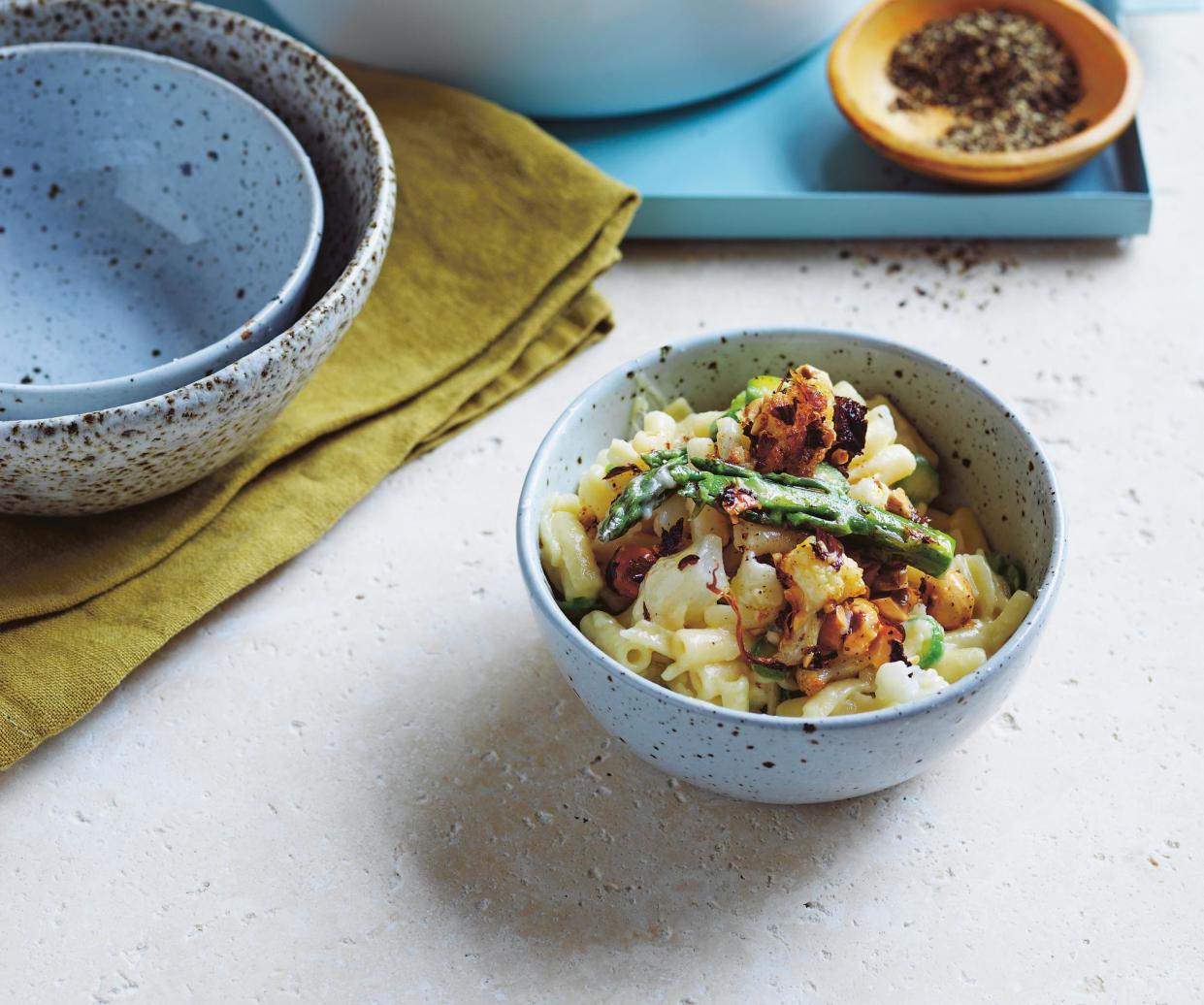Easy and cheesy: Alice Zaslavsky’s cauliflower and asparagus mac ‘n’ cheese – recipe

When it comes to buying cauliflower, the vegetable’s lily-whiteness and delicate flesh make it easy to tell you’re picking a winner. Available for most of the year, peaking in autumn, look for a clean canopy (AKA “curd”) and sprightly leaves. For another good indicator, check underneath where the head has been lopped off from the stalk – the more moisture there, the fresher your florets. Any “ashiness” (in colour and texture) of the stalk or discoloration on the curd tells you these heads have seen some things, but it’s nothing that the flick of a paring knife or peeler can’t solve.
Floppy florets are also not the end of the world – use them in a cauliflower soup and people will be none the wiser. It’s always more cost-effective to buy a whole head and simply add any leftovers – roasted or steamed – to bulk out whatever dish you’re making the next day.
Cauliflower can last up to two weeks in the crisper if the leaves are sprightly when you buy it. If you insist on going with a cauli half, either stand it in a jar of water on the bottom shelf of your fridge or wrap it loosely before storing in the crisper to slow the inevitable drying-out process. Incidentally, you can also freeze blanched cauli florets flat on a tray before packing into portions and popping back into the freezer.
Cauliflower leaves are surprisingly tasty. Wash and pat or spin them dry, tear into pieces, toss with olive oil, vinegar, lemon zest and salt, and lay in a single layer on wire racks set over baking trays, and roast at 160C/140C fan until they’re golden and crispy. If you’re preparing a recipe that only requires the florets, don’t you dare throw out the heart – it’s my favourite bit. Slice off the end of the stalk to show you how much woody outer layer needs to be peeled, then use a paring knife or peeler to access the sweet, sweet paler stalk within. Eat this raw as you might a celery stick, and consider sharing with any small people around. It’ll hook them on brassicas for life – and they might even write about it one day.
‘Double denim’ cauliflower and asparagus mac ‘n’ cheese – recipe
Remember when Justin Timberlake and Britney Spears were dating and went to the American Music Awards wearing double double denim? Well, between his hair (noodles) and her surname (Spears), I bring you this dish. Often, mac ’n‘ cheese recipes are let down by too many steps (I’m looking at you, bechamel sauce), so what I love about this one is that the only thing standing between you and a bowl of oozy deliciousness studded with sumptuous asparagus is how long it takes to boil the pasta. If you don’t have time to fuss around with cooking the veggies, chop the asparagus into fine discs and toss into the colander just before draining the pasta water through it; this will cook the asparagus just enough to take the raw edge off.
You can also grate some of the cauliflower through the cooked pasta just before turning off the heat and draining. Pouring plenty of boiling water over a cupful or two of frozen peas in a bowl is another optional but excellent veg addition.
Serves 4
500g macaroni (or gluten-free pasta)
3–4 bunches of asparagus, about 600g
½ head of cauliflower, with leaves
100g butter
300g comté (or gruyere or cheddar), grated
250g parmesan, grated
Olive oil, for drizzling
For the bonus beurre noisette
80g butter
1 handful of raw or roasted hazelnuts
Grab your largest pot, fill it three-quarters full of water, add plenty of salt and bring to a vigorous boil. Add the macaroni, setting a timer for three minutes before the packet says the pasta will be ready.
Meanwhile, snap off the woody ends of the asparagus and set aside, then slice the stalks and spears into bite-size pieces. Chop the cauliflower into forkful-sized florets and the stalks into bite-size pieces. Cut the leaves to forkful size and set aside.
Melt the 100g butter in a large non-stick saucepan.
Related: ‘What do you call these, love?’: Alice Zaslavsky’s chicken and cauliflower rissoles
When your macaroni timer goes off, pop the cauliflower into the pasta pot then reset the timer for another two minutes. When the timer goes off again, add the asparagus stalks and spears, then reset the timer for one minute more. Scoop out and reserve a mugful of pasta water, then carefully pour the asparagus, cauliflower and pasta mixture into a colander to drain.
To make the beurre noisette, pop the reserved asparagus ends and cauliflower leaves in the now-empty pasta pot with the 80g unmelted butter and hazelnuts. Allow to bubble away and brown over medium heat until the pot smells as though you’re baking cookies in it. Set the vegetables aside for the garnish.
Meanwhile, heat the saucepan containing the melted butter over a medium-high. Sprinkle the comte and about 200g of the parmesan in, then add the cooked pasta, veggies and mugful of reserved pasta water. Stir until everything combines into one glorious oozy mess. Season to taste with salt and plenty of cracked black pepper.
To serve, portion the mac ’n‘ cheese into serving bowls and top with the brown butter mix. Sprinkle with the remaining parmesan, a couple of cracks of black pepper, drizzle with a glug of olive oil and serve.
This is an edited extract from In Praise of Veg by Alice Zaslavsky, photography by Ben Dearnley, published by Murdoch Books in Australia (A$59.99) and the UK (£25), and in the US (US$35) and Canada (C$45) where it is published by Appetite by Random House


